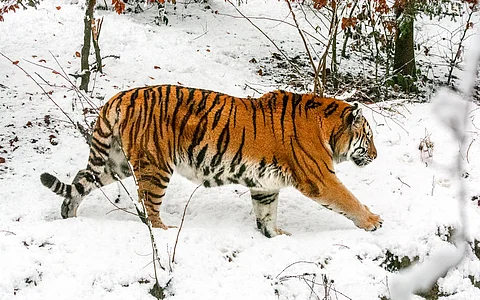

The genetic diversity of a critically important subpopulation of the Amur or Siberian tiger (Panthera tigris altaica) in the Russian Far East is very low despite there being an increase in the subpopulation itself, a new study in Nature has found.
It is important to link this subpopulation with the bulk of the Amur tiger population through ecological corridors, besides conservation strategies and continuous monitoring, the authors recommended.
They also said the microsatellite markers used in their study could be used to study other rare cats in the region like the Amur leopard.
The Amur tiger was once widely distributed from Northeast China and Far Eastern Russia to the Korean Peninsula.
But relentless pressures of indiscriminate hunting, capture for economic gain, and habitat destruction have led to the virtual extinction of Amur tigers across much of their natural range.
The species in now extinct in South Korea, with the last recorded capture dating back to 1921. There were 55 wild Amur tigers counted by camera trap surveys in Northeast China between 2013 and 2018.
But the bulk of the world’s last remaining Amur tigers are now found in the Russian Far East. There are currently 750 individuals in the region, up from the less than 40 tigers left by the 1940s.
But the tiger habitat in Russia has a problem. It is bifurcated into two main parts. The Sikhote-Alin landscape, which houses 90 per cent of Russia’s tigers, is separated from Southwest Primorye, a narrow strip of land in the southernmost area of Primorsky province spanning at least 5,400 square kilometres.
The two are divided by an anthropogenic development corridor between Vladivostok and Khanka Lake.
Southwest Primorye hosts approximately nine per cent of the remaining wild Amur tiger population. The researchers noted that it represented hope for the revival of tigers in Northeast China and the Korean peninsula as it bordered the Laoyeling landscape, which constitutes the major tiger range in China.
The population of tigers in Southwest Primorye is currently 58 individuals (including cubs) according to the 2021-2022 census.
The researchers noted that a small, isolated population that has gone through significant declines (like Southwest Primorye) can often suffer from lack of genetic diversity. “Therefore, these populations require regular genetic monitoring and management to ensure their viability,” stated the paper.
Aiming to estimate the number of individuals in Southwest Primorye and their genetic diversity, and to uncover their demographic history, the researchers investigated their quantitative and qualitative status using DNA extracted from fecal samples.
This, they felt, would provide a background for better understanding this endangered population and formulating appropriate conservation strategies.
“We also genotyped the population using microsatellite markers developed from a genome-wide survey of big cats, which can be reliably applied to multiple feline species, and sequenced mitochondrial DNA using newly designed markers,” the paper noted.
The results turned out to be worrying.
“A total of 32 individuals (16 males, 15 females, and 1 unidentified sex) were identified, and signs of bottlenecks were detected, reflecting past demographic events. Low genetic variation observed in mitochondrial DNA also revealed genetic depletion within the population. Most individuals were found to be closely related to each other, raising concerns about inbreeding given the small population size and somewhat isolated environment from the main population in Sikhote-Alin,” the research read.
Connectivity with the northern tiger population in Shikhote Alin is crucial for genetic recovery of the Southwest Primorye population, concluded the researchers.
“The development corridors still impede the movement between the two populations, and ecological corridors need to be established to connect them. Additionally, there is need of joint population monitoring efforts to manage SW-Laoyeling landscape tiger population,” the authors said.
They also suggested that corridors along the China-North Korea border would extend the species’ range into its vast former ranges, devoid of apex predators, providing optimal environments and abundant prey resources.
Genetic insights and conservation strategies for Amur tigers in Southwest Primorye Russia was published in Nature Scientific Reports on December 2, 2024.